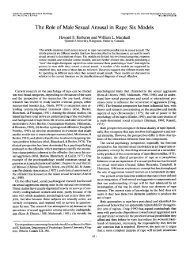Regulation of the dopamine transporter - Addiction Research ...
Regulation of the dopamine transporter - Addiction Research ...
Regulation of the dopamine transporter - Addiction Research ...
You also want an ePaper? Increase the reach of your titles
YUMPU automatically turns print PDFs into web optimized ePapers that Google loves.
Schmitt & Reith DAT <strong>Regulation</strong><br />
and that this trafficking can be rapidly regulated,<br />
findings <strong>of</strong> in vitro amphetamine-induced reduction<br />
in <strong>transporter</strong> radioligand binding were interpreted<br />
as evidence <strong>of</strong> <strong>the</strong> in vivo neurotoxicity <strong>of</strong><br />
<strong>the</strong>se compounds. With <strong>the</strong> new knowledge on DAT<br />
trafficking phenomena, such findings will need to be<br />
reinterpreted. In <strong>the</strong> following, we will discuss <strong>the</strong><br />
possible implications <strong>of</strong> <strong>transporter</strong> protein regulation<br />
to <strong>the</strong> putative toxicity <strong>of</strong> several substituted<br />
amphetamine derivatives that are <strong>of</strong>ten encountered<br />
as drugs <strong>of</strong> addiction (<strong>the</strong> prototypical example being<br />
methamphetamine) and/or recreational drugs.<br />
We will also discuss <strong>the</strong> potential utility <strong>of</strong> agents<br />
that reduce plasmalemmal DAT expression in <strong>the</strong><br />
rectification <strong>of</strong> <strong>dopamine</strong>rgic neuroadaptation that<br />
occurs in chronic cocaine addiction. 37,40<br />
The amphetamines are an immensely diverse class<br />
<strong>of</strong> compounds and <strong>the</strong> structure-activity relationship<br />
<strong>of</strong> <strong>the</strong> amphetaminergic structural framework<br />
has been thoroughly investigated. 112 Amphetamine<br />
derivatives can elicit a wide range <strong>of</strong> phenomenological<br />
and neurochemical effects; however, for this<br />
discussion, we will focus solely on stimulant-like<br />
amphetamine derivatives that act as monoamine<br />
<strong>transporter</strong> substrates and will not consider any <strong>of</strong><br />
<strong>the</strong> psychedelic amphetamine derivatives, which act<br />
primarily at serotonin 5-HT2 receptors. 113 Whereas<br />
amphetamine itself exhibits roughly equipotent<br />
substrate activity at <strong>the</strong> DAT and NET with little<br />
meaningful activity at <strong>the</strong> SERT—amphetamine inhibits<br />
[ 3 H]DA and [ 3 H]NE uptake with 112- and 98fold<br />
greater potency than [ 3 H]5-HT, respectively—<br />
certain amphetamine analogues bearing substitutions<br />
on <strong>the</strong> phenyl ring and amine nitrogen have<br />
unique activity pr<strong>of</strong>iles at <strong>the</strong> three monoamine<br />
<strong>transporter</strong>s. 114 For example, aromatic substitution<br />
with a bulky, electron-rich moiety (such as a<br />
methoxy group or a halogen larger than fluorine) at<br />
<strong>the</strong> 3- or 4-position usually decreases substrate activity<br />
at <strong>the</strong> DAT but concomitantly increases affinity<br />
toward <strong>the</strong> SERT. 115,116 Hence, amphetamine<br />
derivatives, such as 4-chloroamphetamine (PCA),<br />
4-methoxyamphetamine (4-MA; more traditionally<br />
known as PMA, but we shall refer to it as 4-MA<br />
to prevent confusion with <strong>the</strong> phorbol ester �-<br />
PMA) and 3-trifluoromethyl-N-ethylamphetamine<br />
(fenfluramine) are <strong>of</strong>ten labeled as “serotonergic<br />
amphetamines” (although PCA still possesses<br />
significant affinity for both <strong>the</strong> DAT and<br />
NET 116 ). Alkylation <strong>of</strong> <strong>the</strong> amphetamine nitro-<br />
gen to <strong>the</strong> secondary amine generally increases<br />
SERT affinity without drastically altering potency<br />
at ei<strong>the</strong>r <strong>the</strong> DAT or NET; however, alkyl<br />
moieties longer than N-ethyl impede substratelike<br />
activity, with d-N-butylamphetamine being<br />
virtually inactive in behavioral assays. 117<br />
Therefore, d-methamphetamine exhibits roughly<br />
2.5-fold greater potency than d-amphetamine<br />
as a SERT substrate. 115 The empathogen 3,4methylenedioxyamphetamine<br />
(MDA) and its Nmethyl<br />
analogue (MDMA)—both widely used<br />
recreational drugs, <strong>of</strong>ten sold (with any number <strong>of</strong><br />
admixes) under <strong>the</strong> name “ecstasy”—have affinity<br />
for all three <strong>of</strong> <strong>the</strong> monoamine <strong>transporter</strong>s, with<br />
slightly greater substrate activity at <strong>the</strong> SERT and<br />
NET than at <strong>the</strong> DAT. 118–120 SERT-affecting substituted<br />
amphetamine analogues decrease plasmalemmal<br />
SERT expression, paralleling <strong>the</strong> endocytic effect<br />
that amphetamine itself has on <strong>the</strong> DAT. Acute<br />
administration <strong>of</strong> high doses <strong>of</strong> d-fenfluramine or<br />
PCA to rats decreases <strong>the</strong> Bmax for SERT radioligand<br />
binding by 30–60% (depending upon <strong>the</strong> interval<br />
after drug administration), without significant<br />
changes in whole-cell SERT protein levels, 121 as<br />
measured by Western blot analysis (but also see Xie<br />
et al. 122 ). MDMA has also been frequently shown<br />
to cause loss <strong>of</strong> both radiolabeled SERT and DAT<br />
binding sites in experimental animals. 123–125<br />
Because monoaminergic neurotransmission is so<br />
intimately involved in cognition, affect, behavioral<br />
reinforcement, and motor function, 2,126 it is not surprising<br />
that <strong>the</strong> implications <strong>of</strong> substrate-induced<br />
monoamine <strong>transporter</strong> downregulation on human<br />
physiological and psychical function are highly debated<br />
topics. The amphetaminergic substrate that<br />
has received <strong>the</strong> most attention in this debate is<br />
MDMA. Because <strong>of</strong> its widespread popularity as a<br />
recreational drug and nearly ubiquitous presence in<br />
<strong>the</strong> party scene, ascertaining <strong>the</strong> potential <strong>of</strong> recreational<br />
doses <strong>of</strong> MDMA to elicit neurotoxicity in<br />
humans is an important public health question.<br />
Fur<strong>the</strong>rmore, elucidation <strong>of</strong> <strong>the</strong> mechanism underlying<br />
MDMAergic neurotoxicity will also provide<br />
insight into strategies to minimize potential damage<br />
dealt by recreational MDMA use.<br />
Initial neurochemical studies in rats revealed a<br />
dramatic and protracted reduction in <strong>the</strong> density <strong>of</strong><br />
SERT expression and in total brain 5-HT content<br />
after high doses <strong>of</strong> ei<strong>the</strong>r MDA or MDMA. 123 Similar<br />
losses <strong>of</strong> SERT expression were observed after<br />
Ann. N.Y. Acad. Sci. 1187 (2010) 316–340 c○ 2010 New York Academy <strong>of</strong> Sciences. 329










